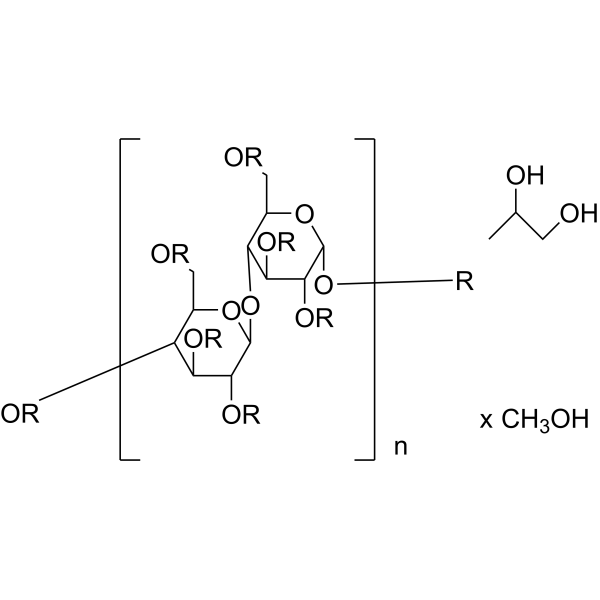9004-65-3
| Name | Hypromellose |
|---|---|
| Synonyms |
2-Hydroxypropyl 2,3,6-tris-O-(2-hydroxypropyl)-4-O-[2,3,4,6-tetrakis-O-(2-hydroxypropyl)-β-D-glucopyranosyl]-β-D-glucopyranoside - methyl 2,3,6-tri-O-methyl-4-O-(2,3,4,6-tetra-O-methyl-β-D-gl ucopyranosyl)-β-D-glucopyranoside (1:1)
Hydroxypropyl methyl cellulose EINECS 220-971-6 MHPC Hydroxypropyl methylcellulose MFCD00131360 E464 β-D-Glucopyranoside, 2-hydroxypropyl 2,3,6-tris-O-(2-hydroxypropyl)-4-O-[2,3,4,6-tetrakis-O-(2-hydroxypropyl)-β-D-glucopyranosyl]-, compd. with β-D-glucopyranoside, methyl 2,3,6-tri-O-methyl- 4-O-(2,3,4,6-tetra-O-methyl-β-D-glucopyranosyl)- (1:1) HPMC |
| Description | Hypromellose is a water-soluble hydrophilic, non-ionic cellulose ether used to form swellable-soluble matrices. |
|---|---|
| Related Catalog | |
| In Vitro | Hypromellose provides the release of a drug in a controlled manner, effectively increasing the duration of release of a drug to prolong its therapeutic effect[1]. Hypromellose (hydroxypropylmethylcellulose) has been used in sustained-release pharmaceutical products for many years. When used in matrix tablets, these polymers hydrate on contact with water to produce a viscous gel barrier within and surrounding the tablet. The properties of hypromellose that affect the rate of drug release include the rate of diffusion of water into the dry polymer, the rate of hypromellose hydration and gel formation, the viscosity of the hydrated hypromellose and rate of hypromellose gel erosion[2]. |
| In Vivo | Punctal occlusion using hypromellose 2% is a low-cost and safe additional treatment for dry eye. Fluorescein and rose bengal staining tests show that there was a significant reduction in signs after occlusion using hypromellose[3]. Hypromellose is effective in improving the blood glucose metabolism and suppressing oxidative stress in mice fed with a high fat diet. The antihyperglycemic and antioxidative effects of hypromellose could be partly attributed to the regulation of hepatic glucose-regulating enzyme activities and activation of the hepatic and erythrocyte antioxidant enzymes. Hypromellose may be useful as biomaterials in the development of functional food or as therapeutic agents against high fat-induced hyperglycemia and oxidative stress[4]. |
| References |
[2]. Braund R, et al. Hypromellose films for the delivery of growth factors for wound healing. |
| Density | 1.39 |
|---|---|
| Molecular Formula | C18H38O14 |
| Molecular Weight | 478.49 |
| Appearance | powder |
| Stability | Stable. Solid is combustible, incompatible with strong oxidizing agents. |
| Water Solubility | H2O: 50 mg/mL, clear to very faintly turbid, faintly yellow | SOLUBLE |
| Personal Protective Equipment | Eyeshields;Gloves;type N95 (US);type P1 (EN143) respirator filter |
|---|---|
| Hazard Codes | Xi |
| Safety Phrases | 24/25 |
| RIDADR | NONH for all modes of transport |
| WGK Germany | 1 |
| RTECS | NF9125000 |


